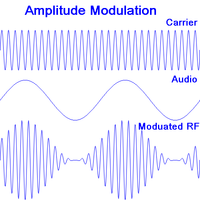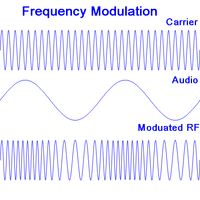How radios work: Difference between revisions
No edit summary |
|||
| Line 32: | Line 32: | ||
Error correction bits are added to the compressed output of the codec allowing short sequences of corrupted bits to be corrected at the receiving end, and longer sequences to be detected. The resultant data streams from a number of different programmes are then multiplexed together creating an "ensemble" which is used to modulate a carrier. | Error correction bits are added to the compressed output of the codec allowing short sequences of corrupted bits to be corrected at the receiving end, and longer sequences to be detected. The resultant data streams from a number of different programmes are then multiplexed together creating an "ensemble" which is used to modulate a carrier. | ||
DAB+ is a newer variant which uses a more efficient codec and more powerful error correction, allowing more programmes to be broadcast in a single ensemble. Whilst it allows successful reception of a weaker signal, there is a sharper "cliff edge" where a weak signal degenerates into a burbling noise | A digital receiver simply performs all these processes in reverse. | ||
DAB+ is a newer variant which uses a more efficient codec and more powerful error correction, allowing more programmes to be broadcast in a single ensemble. Whilst it allows successful reception of a weaker signal, there is a sharper "cliff edge" where a weak signal degenerates into a burbling noise before being lost. | |||
==Types of Radio== | ==Types of Radio== | ||
Revision as of 10:01, 6 December 2016
A brief introduction to how radios work.
Summary
Often, radios can be fixed simply by looking for the sort of problems common to all electronic gadgets, with very little idea of how they actually work. But when that approach fails, it's necessary to have a basic grounding in the theory of operation in order to go deeper. That is what this Wiki page is intended to provide.
We start by looking at the basic theory of radio transmission, then go on to examine how that theory is put into practice in several different types of radio.
Basic radio theory
In theory, you might be able to connect a microphone, through a powerful amplifier, directly to a transmitting aerial. In practice that wouldn't work because (for reasons we'll come to) you'd need an aerial many miles long, and there'd be no way to transmit more than one programme at a time without them getting mixed up.
An Audio Frequency (AF) signal, such as comes out of a microphone or could be fed into a loudspeaker, consists of frequencies in the range 20Hz - 20kHz (20 - 20,000 vibrations per second). In order to transmit it, that signal has to be impressed in some way upon a much higher Radio Frequency (RF) "carrier". There are several ways of doing that, the process being known as "modulation". A radio receiver essentially has two jobs to do: firstly, selection and amplification of the modulated carrier from that station you want to listen to ("tuning", and "demodulation", or recovering and amplifying the audio signal from it.
We'll look at several methods of modulation, then explain how tuning is achieved.
Amplitude Modulation (AM)
The simplest form of modulation is Amplitude Modulation, or AM. As shown in the diagram, the audio (AF) signal is impressed on the RF carrier as changes in amplitude.
Demodulation is simple. If you were to feed the modulated RF directly into a loudspeaker, you would hear nothing as it's positive just as much as it's negative and the cone would be quite unable to follow the RF oscillations. But if you chop off all the negative bits the net positive that is left will follow the original AF signal, which the speaker will be able to reproduce.
A disadvantage of AM is that it's susceptible to interference from things like a sparking electric motor, a car's ignition system or the fridge turning on and off. These all generate spike of amplitude which the loudspeaker reproduces as clicks.
Frequency Modulation (FM)
In Frequency modulation or FM, the amplitude of the carrier remains the same but the frequency is varied in sympathy with the audio signal, as shown in the second digram. There are several methods of demodulation and these are generally slightly more complicated than for AM but fortunately we don't need to go into them for the purposes of repair.
An advantage of FM is that any spikes in the signal from interference can simply be chopped off by limiting the amplitude to a maximum value, with the result that they will hardly be heard in the audio output.
Digital Modulation
In digital radio (DAB, or Digital Audio Broadcasting) the audio signal is first converted to digital. The amplitude of the signal (or each channel in the case of stereo) is measured and converted to a binary number many times per second. The absolute minimum rate is twice for every cycle, so for audio containing frequencies up to 20kHz the minimum "sampling rate" as it's called is 40,000 samples per second.
This produces rather a lot of data, but since each sound wave typically only differs slightly from the previous one there is much scope for data compression. This is done by a codec (coder-decoder).
Error correction bits are added to the compressed output of the codec allowing short sequences of corrupted bits to be corrected at the receiving end, and longer sequences to be detected. The resultant data streams from a number of different programmes are then multiplexed together creating an "ensemble" which is used to modulate a carrier.
A digital receiver simply performs all these processes in reverse.
DAB+ is a newer variant which uses a more efficient codec and more powerful error correction, allowing more programmes to be broadcast in a single ensemble. Whilst it allows successful reception of a weaker signal, there is a sharper "cliff edge" where a weak signal degenerates into a burbling noise before being lost.
Types of Radio
Tuned Radio Frequency (TRF)
Superhet
Digital
External links
- External links (if any) as bullet points.
- If non, delete this section.

